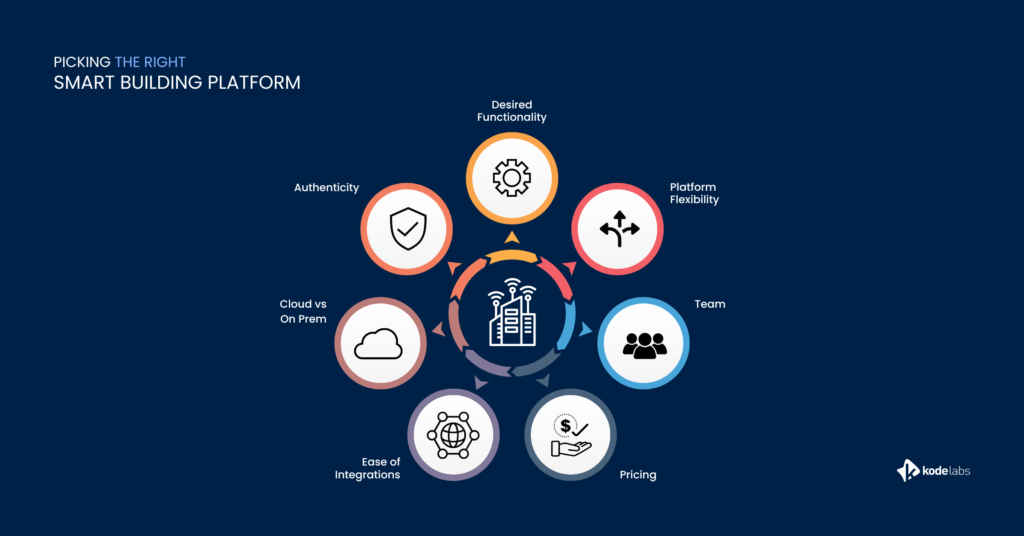The Smart Building industry is facing a rapid increase in demand, accelerated by various factors such as the need to react to work-from-home trends and increased ESG requirements set at company and government scales. However, this rapid rise has come with a vacuum in knowledge on how to select the right technology solutions. This is especially true for smart building platforms, which, while being the most recent addition to the industry, can have the highest impact on whether a building’s smart technology is successful in driving the desired efficiencies. In this article we will explore various factors that are important to consider when choosing between different smart building platforms.
Desired Functionality
Before technical details are to be considered, it’s important to have a crystallized vision of what one wants out of a smart building platform. Certain platforms are designed to focus on one subset of functionality (ex. energy analytics) and others are designed to be an all-in-one platform. Similarly, certain platforms focus on data analysis, while others are catered purely for deploying optimization algorithms. Subsequently, smart building platforms can take many different shapes and sizes, and one will only be satisfied with their platform of choice if they pick one that will cater to their needs.
Therefore, it is recommended that a smart building owner should critically evaluate what type of functionalities are most essential for them before looking at the market for potential platforms. Furthermore, it’s also a useful exercise to consider who in the client organization would be utilizing the platform most, as it is this team who would benefit/be disrupted most by the selected product.
Being selective about desired features also opens the opportunity to save costs when selecting a platform. Instead of purchasing a platform with all of its modules, a number of which may be non-essential, one can lower the price by purchasing only a subset of the platform’s functionality.
Platform Flexibility
While it is important to have a clear picture of the desired smart building functionalities, it’s equally crucial to gather information on the flexibility of the platform. Flexibility can be viewed as the ability for a smart building platform to adapt to changing needs of its users. This can range from the ability of the platform to easily switch between cloud/on-premise to its ability to customize/add/remove various features to meet client requirements.
There is inevitably going to be a discovery phase after the initial deployment of a smart building platform, where certain features may stand out, and other previously desired features look to be less important than they initially seemed. Furthermore, this industry is still evolving rapidly, and features today may not be relevant tomorrow. It’s important to look for a platform vendor that recognizes these facts and is willing to cater the platform to the client not only in the short term but also the long term, as the client learns to navigate a new way to manage and operate their real estate.
Team / Background
Smart building platforms can greatly impact a building’s day-to-day operation through their features and data. One can go so far as to say that selecting a smart building platform is less like buying a software and more like beginning a partnership with a technology team. This is because, while such platforms are commonly viewed as building system vendors, their impact and behavior is closer to that of enterprise technology solutions. Consequently, a platform vendor should always be able to provide dedicated support to ensure that their product and services are actually improving the client’s experience and performance.
Furthermore, once deployed, a smart building platform is deeply integrated with a building’s large systems such as HVAC, lighting, and fire. This makes it crucial that the vendor has 24-hour support when the client needs assistance with any anomalous behavior. In addition, it is also important that the vendor has a multidisciplinary team of software, building and IoT experts who can not only help support the client if issues arise but also help the client spot areas of opportunities to get the most out of their platform and building.
Another valuable criteria to assess, is the network of partners, especially local channels, that a smart building software vendor has. Having the ability to call someone onsite for training or technical support is a valuable asset for a building engineering team. Having a vendor with such a network of partners will ensure that the building can be well supported even in the situations where over-the-phone help is insufficient.
Pricing
Understanding a smart building vendor’s pricing model provides a small window into what their priorities are with regards to their deployment preferences and go-to-market strategy. At its simplest, platforms are either priced as a one-time deployment, or, are priced as a SaaS model. While one-time deployment cost may be simpler, it is often much larger than the upfront cost of a SaaS based deployment. This can be a limiting factor for buildings with smaller CapEx budgets. Furthermore, while this should not be considered a litmus test, it is an undeniable fact that platforms that charge a one-time deployment fee are not financially incentivized to provide long-term support to a client. In contrast, platforms following the SaaS model have ongoing service costs embedded into the subscription fees. In addition to reviewing the pricing model of a one-time deployment, it is also worth reviewing how a platform’s pricing evolves if scaled across a portfolio. A truly scalable platform vendor will ensure that, if their product is deployed across multiple buildings, there is a decreasing cost to deploy per added building. One sign of a platform vendor showcasing such a characteristic is if they reduce the $ per point / $ per sqft rate of deployment as they proliferate across a portfolio.
Similarly, another characteristic is their ability to lower their one-time deployment cost as they come across buildings with the same technologies. Having a platform that is committed to making scaling easier, not just through features but also financially, will unlock a client’s ability to enact operational efficiencies across not just one or two buildings, but a whole campus or portfolio.
Ease of Integration
Similar to pricing, an essential piece to the success of a smart building platform is its flexibility and ease of integration. Smart building platforms leverage the building’s already existing systems to command and control the equipment onsite. Understanding how exactly a platform integrates with such systems will allow clients to better assess factors such as but not limited to:
- The depth of insight + command/control that will be provided by the platform. This will correlate with the kind of functionalities/features the platform will be able to enable for the client.
- The scalability / speed of deployment of the platform. Based on how smart building platforms develop their integrations, their deployment time can range from days to months.
- The data traffic / network load placed on a building’s existing infrastructure. With smart building platforms pulling and pushing data to a variety of equipment, it’s important to assess what kind of impact they may have on the building’s infrastructure, as this can affect system performance.
- Potential hidden costs of deployment. Normally, building systems aren’t ready to integrate off the bat, and certain add-on licenses/gateways may have to be procured in order to “unlock” their data. Better comprehension of a platform’s approach to integration will allow teams to uncover such potential hidden costs.
Often, it is recommended to collect as much documentation on the building’s existing systems and provide it to the platform vendor, to allow them to present a plan of attack as to how they will integrate with the building’s equipment. Being able to review and analyze the vendor’s integration methodology will help ensure transparency when it comes to any deployment implications.
Cloud vs. On-Premise
While this is a more specific subject than the previously discussed factors, it is important to assess the potential implications of cloud-based vs. on-premise smart building platforms. Each approach comes with its own host of advantages and disadvantages, however, internal building teams may have policies that impact which approach is the right one for the client. It is still commonplace for vendors to be selected who are then halted from deploying their product by internal IT teams due to cybersecurity or infrastructure policies. Below is a table describing some of the differences between each approach:
| Cloud-Based | On-Premise | |
| Pros | – Little to no added infrastructure is needed onsite. – In practice, more secure than on-prem (no phishing/ less modes of entry/easier deployment of encryption). – Easily scalable and adaptable (added memory/ computational power is a matter of allocating more resources vs. onsite hardware modifications). – Significantly lower costs. | – More control over system deployment. – More customizability (ex. Servers can be moved around and allocated as desired by client team). – More control over system uptime/downtime. |
| Cons | – Less control over compute power / resources – External connection between building and platform vs on-prem – Cloud fees can change by cloud provider choice (historically however, this change has always been a decrease in cost) vs. on-prem which stays consistent | – Significant expense to deploy due to cost of hardware, cost of installation, cost of maintenance and cost for a team to support solution – Platform maintenance and updates will happen less frequently as vendor will not be able to readily access and deploy updates – Higher chance of security / data loss due to having less resources to manage deployment in comparison to commercial cloud platforms |
The advantages and disadvantages of cloud vs on-prem are often nuanced and largely dependent on the real estate company’s infrastructure. However, cloud-based technology is on the rise due to its ease of use and ability to scale with minimal added costs. On-premise solutions are only preferable if the client has an established infrastructure in place along with a dedicated team committed to ensuring that this infrastructure remains operational and secure.
Certain smart building platforms have the capability of deploying on both cloud and on-premise, making them a good choice for teams that have not yet selected their internal strategy for smart building infrastructure.
Platform & Product Authenticity
At the risk of sounding cliche, it is always recommended to explore the authenticity of a platform before selecting it. Simple measures such as asking for and contacting client references can prove very effective in understanding which platforms will truly solve one’s pain points and which ones won’t. Furthermore, certain platform vendors may even provide pilot deployments to prove their value, allowing a client to assess a live sample of what their end product may look like. In an industry littered with buzz words and ever-changing trends, it is ever-more crucial to assess the ability of a company to stand behind their product and promises.
Conclusion
Making the right decision on what smart building platform to deploy can unlock significant savings at a building level along with opening up opportunities to enhance tenant/employee experience. When making such a decision, it is important for owners and operators to assess platforms by using the discussed factors, such as their own vision for what they want out of such a platform, along with the platform’s flexibility, ease of integration, and pricing. Furthermore, it is never a bad idea to simply call a platform’s references to hear their experience with the product. A smart building platform can revolutionize the way a building and portfolio is operated. While the decision making process of selecting such a platform can seem quite complex, all building owners would greatly benefit from exploring the potential such a technology holds.
About the Author




